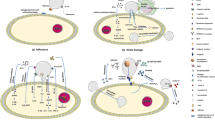Abstract
We have previously shown that infection with Chlamydia pneumoniae can significantly exacerbate atherosclerotic lesions in LDLR—/— mice concurrently fed a high cholesterol diet in 6 or 9 months. We now report that a period of 4 month was sufficient for demonstrating the C. pneumoniae atherogenicity. However, heat inactivation of C. pneumoniae organisms completely abolished the ability of C. pneumoniae to exacerbate the atherosclerotic lesions, suggesting that viable organism infection may be required for the C. pneumoniae atherogenicity.
Similar content being viewed by others
References
Grayston JT, Kuo CC, Coulson AS, Campbell LA, Lawrence RD, Lee MJ, Strandness ED, Wang SP: Chlamydia pneumoniae (TWAR) in atherosclerosis of the carotid artery (see comments). Circulation 92: 3397-3400, 1995
Saikku P, Leinonen M, Mattila K, Ekman MR, Nieminen MS, Makela PH, Huttunen JK, Valtonen V: Serological evidence of an association of a novel Chlamydia, TWAR, with chronic coronary heart disease and acute myocardial infarction. Lancet 2: 983-986, 1988
Puolakkainen M, Kuo CC, Shor A, Wang SP, Grayston JT, Campbell LA: Serological response to Chlamydia pneumoniae in adults with coronary arterial fatty streaks and fibrolipid plaques. J Clin Microbiol 31: 2212-2214, 1993
Ong G, Thomas BJ, Mansfield AO, Davidson BR, Taylor-Robinson D: Detection and widespread distribution of Chlamydia pneumoniae in the vascular system and its possible implications. J Clin Pathol 49: 102-106, 1996
Kuo CC, Grayston JT, Campbell LA, Goo YA, Wissler RW, Benditt EP: Chlamydia pneumoniae (TWAR) in coronary arteries of young adults (15–34 years old). Proc Natl Acad Sci USA 92: 6911-6914, 1995
Ramirez JA: Isolation of Chlamydia pneumoniae from the coronary artery of a patient with coronary atherosclerosis. The Chlamydia pneumoniae/Atherosclerosis Study Group. Ann Intern Med 125: 979-982, 1996
Kalayoglu MV, Perkins BN, Byrne GI: Chlamydia pneumoniae-infected monocytes exhibit increased adherence to human aortic endothelial cells. Microbes Infect 3: 963-969, 2001
Mahdi OS, Horne BD, Mullen K, Muhlestein JB, Byrne GI: Scrum immunoglobulin G antibodies to chlamydial heat shock protein 60 but not to human and bacterial homologs are associated with coronary artery disease. Circulation 106: 1659-1663, 2002
Fong IW, Chiu B, Viira E, Tucker W, Wood H, Peeling RW: Chlamydial heat-shock protein-60 antibody and correlation with Chlamydia pneumoniae in atherosclerotic plaques. J Infect Dis 186: 1469-1473, 2002
Fong IW, Chiu B, Viira E, Fong MW, Jang D, Mahony J: Rabbit model for Chlamydia pneumoniae infection. J Clin Microbiol 35: 48-52, 1997
Muhlestein JB: Chlamydia pneumoniae-induced atherosclerosis in a rabbit model. J Infect Dis 181(suppl 3): S505-S507, 2000
Hu H, Pierce GN, Zhong G: The atherogenic effects of chlamydia are dependent on serum cholesterol and specific to Chlamydia pneumoniae. J Clin Invest 103: 747-753, 1999
Campbell LA, Kuo C: Mouse models of Chlamydia pneumoniae infection and atherosclerosis. Am Heart J 138: S516-S518, 1999
Moazed TC, Campbell LA, Rosenfeld ME, Grayston JT, Kuo CC: Chlamydia pneumoniae infection accelerates the progression of atherosclerosis in apolipoprotein E-deficient mice. J Infect Dis 180: 238-41, 1999
Liu L, Hu H, Ji H, Murdin AD, Pierce GN, Zhong G: Chlamydia pneumoniae infection significantly exacerbates aortic atherosclerosis in an LDLR-/-mouse model within 6 months. Mol Cell Biochem 215: 123-128, 2001
Blessing E, Campbell LA, Rosenfeld ME, Chough N, Kuo CC: Chlamydia pneumoniae infection accelerates hyperlipidemia induced atherosclerotic lesion development in C57BL/6J mice. Atherosclerosis 158: 13-17, 2001
Zhong G, Fan P, Ji H, Dong F, Huang Y: Identification of a chlamydial protease-like activity factor responsible for the degradation of host transcription factors. J Exp Med 193: 935-942, 2001
Bird DA, Tangirala RK, Fruebis J, Steinberg D, Witztum JL, Palinski W: Effect of probucol on LDL oxidation and atherosclerosis in LDL receptor-deficient mice. J Lipid Res 39: 1079-1090, 1998
Tangirala RK, Rubin EM, Palinski W: Quantitation of atherosclerosis in murine models: correlation between lesions in the aortic origin and in the entire aorta, and differences in the extent of lesions between sexes in LDL receptor-deficient and apolipoprotein E-deficient mice. J Lipid Res 36: 2320-2328, 2002
Fong IW, Chiu B, Viira E, Jang D, Mahony JB: Influence of clarithromycin on early atherosclerotic lesions after Chlamydia pneumoniae infection in a rabbit model. Antimicrob Agents Chemother 46: 2321-2326, 2002
Yang J, Hooper WC, Phillips DJ, Tondella ML, Talkington DF: Induction of proinflammatory cytokines in human lung epithelial cells during Chlamydia pneumoniae infection. Infect Immun 71: 614-620, 2003
Donath B, Fischer C, Page S, Prebeck S, Jilg N, Weber M, da Costa C, Neumeier D, Miethke T, Brand K. Chlamydia pneumoniae activates IKK/I kappa B-mediated signaling, which is inhibited by 4-HNE and following primary exposure. Atherosclerosis 165: 79-88, 2002
Netea MG, Kullberg BJ, Galama JM, Stalenhoef AF, Dinarello CA, Van der Meer JW: Non-LPS components of Chlamydia pneumoniae stimulate cytokine production through Toll-like receptor 2-dependent pathways. Eur J Immunol 32:1188-1195, 2002
LaVerda D, Kalayoglu MV, Byrne GI. Chlamydial heat shock proteins and disease pathology: new paradigms for old problems? Infect Dis Obstet Gynecol 7: 64-71, 1999
Gerdes VE, Verkooyen RP, Kwa VI, de Groot E, van Gorp EC, ten Cate H, Brandjes DP, Buller HR: Chlamydial LPS antibodies, intima-media thickness and ischemic events in patients with established atherosclerosis. Atherosclerosis 167: 65-71, 2003
Kalayoglu MV, Byrne GI: A Chlamydia pneumoniae component that induces macrophage foam cell formation is chlamydial lipopolysac-charide. Infect Immun 66: 5067-5072, 1998
Author information
Authors and Affiliations
Rights and permissions
About this article
Cite this article
Sharma, J., Niu, Y., Ge, J. et al. Heat-inactivated C. pneumoniae organisms are not atherogenic. Mol Cell Biochem 260, 147–152 (2004). https://doi.org/10.1023/B:MCBI.0000026066.64125.71
Issue Date:
DOI: https://doi.org/10.1023/B:MCBI.0000026066.64125.71




